Soursop ‘Guanabana’ Tree Grow This Unique Tropical Fruit at Home
The soursop, or guanabana, is a tropical fruit renowned for its distinctive taste and health benefits. Originating in the Americas’ warm regions, it thrives in home gardens under the right conditions.
This guide covers all aspects of soursop cultivation, including:
By following these guidelines, enthusiasts can enjoy the unique flavor of home-grown soursop. Discover the joys of nurturing a soursop tree and savor its exotic fruit in your garden.
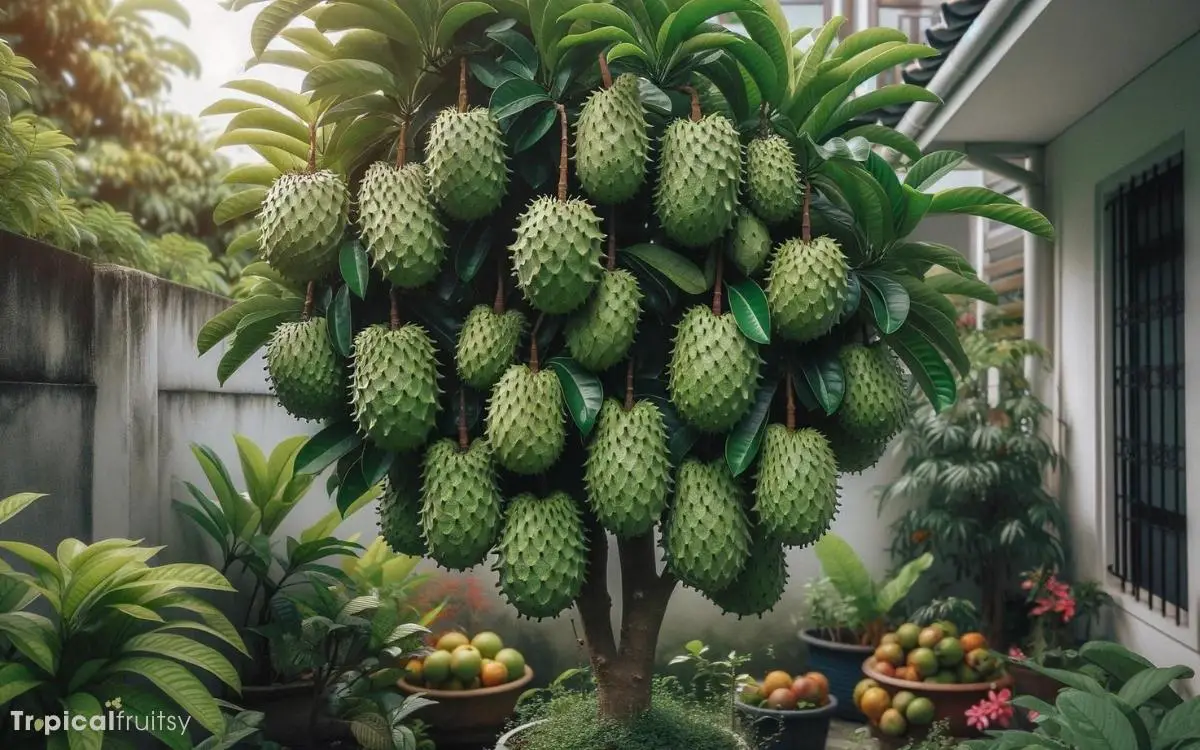
Key Takeaway
Essential Guide to Plant Growth and Care
| Growth Stage | Description | Tips |
|---|---|---|
| Site Selection | Choose a warm, sunny area with well-draining soil. | Protect from strong winds. |
| Planting | Plant young trees during warm seasons. | Space trees 15-20 feet apart. |
| Watering | Keep soil consistently moist. | Avoid waterlogging. |
| Fertilizing | Apply balanced fertilizer regularly. | Monitor nutrient levels. |
| Pruning | Remove dead or overgrown branches. | Promote air circulation. |
| Pest Control | Inspect for common pests like aphids. | Use natural deterrents. |
| Disease Management | Look out for signs of fungal infections. | Apply fungicides if needed. |
| Harvesting | Pick fruit when slightly soft to the touch. | Use caution with spiky skin. |
Understanding Soursop Basics
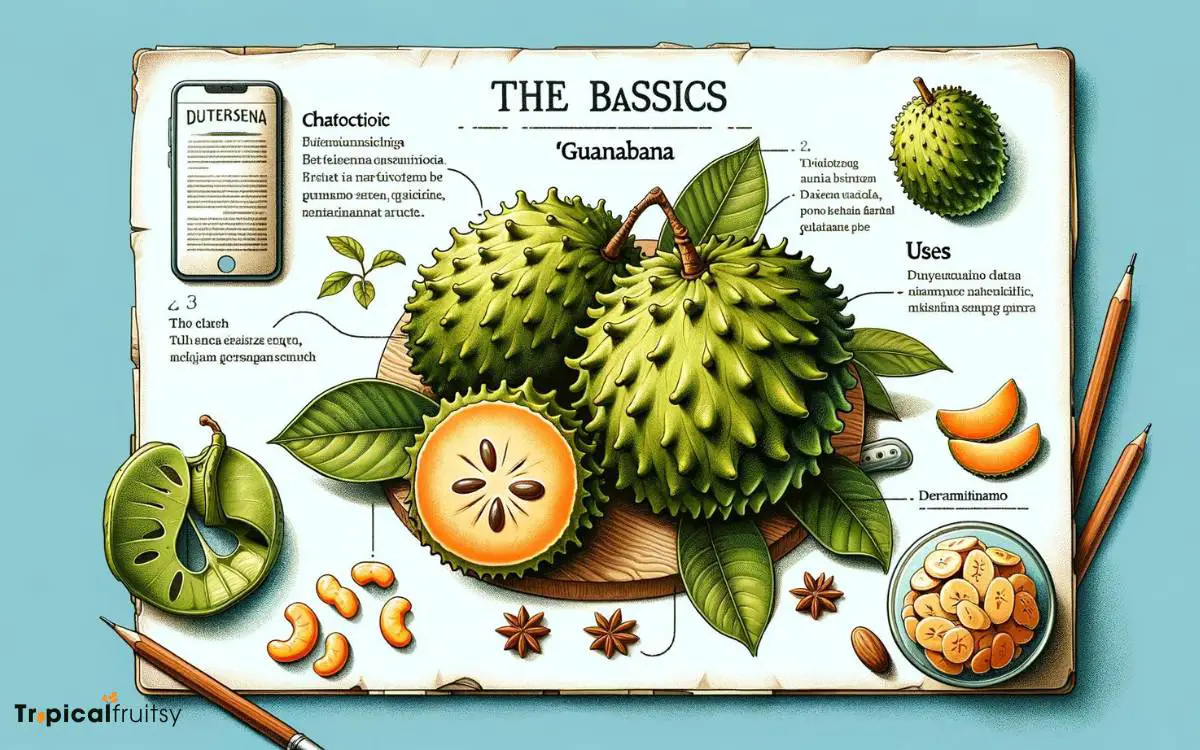
Before you embark on growing your own soursop, or ‘guanabana’, it’s essential to grasp the fundamental characteristics of this tropical fruit tree.
Indigenous to the Caribbean and parts of Central and South America, the soursop tree thrives in warm, humid climates and is not frost-tolerant. It requires well-drained soil with high organic content to support its robust root system.
Soursop trees can grow to heights of 15 to 30 feet and need ample space to flourish. The large, dark green, glossy leaves are accompanied by yellowish flowers that develop into the distinct, spiky fruit.
The soursop fruit itself has a unique flavor, often described as a combination of strawberry, pineapple, and citrus notes, with a creamy texture akin to banana or coconut.
Optimal Growing Conditions
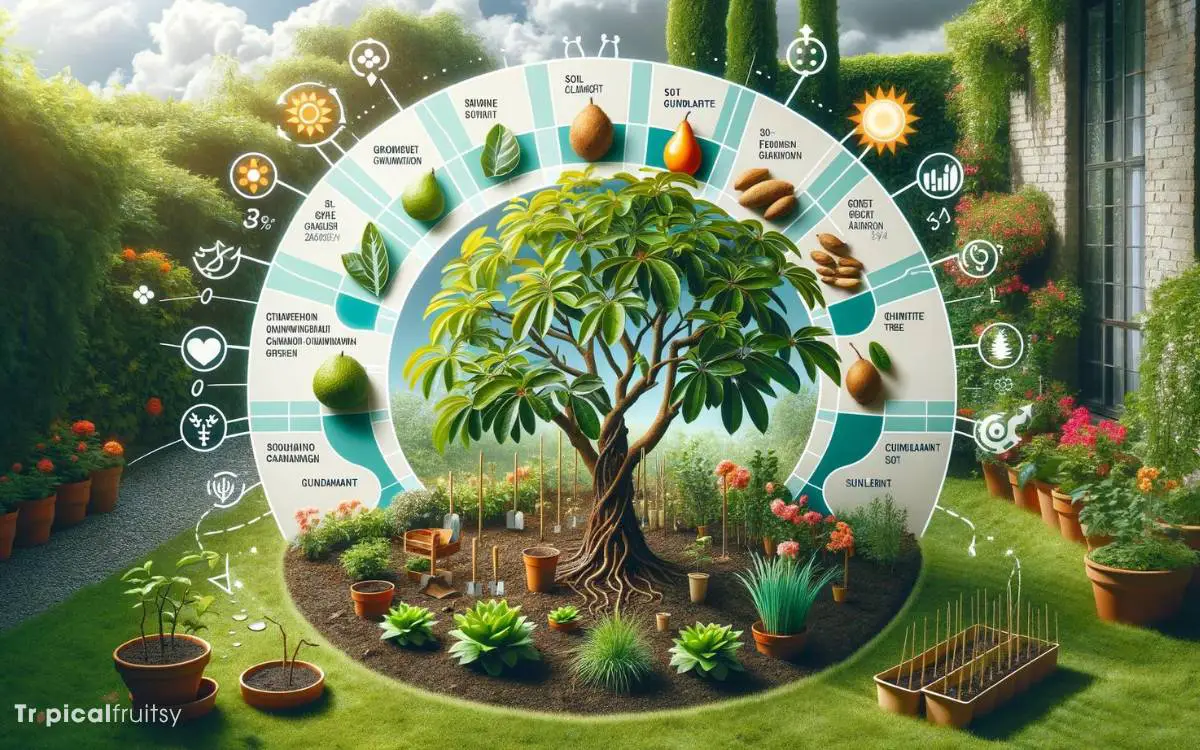
Climate is the paramount factor in cultivating a healthy soursop ‘guanabana’ tree, as it demands a consistently warm temperature range and high humidity to thrive.
For gardeners aspiring to grow this tree, consider these conditions indispensable:
Temperature:
- Ideal: Between 77°F and 91°F (25°C to 33°C).
- Avoid: Temperatures below 28°F (-2°C) can be fatal.
Humidity:
- Soursop trees flourish with 80% or higher humidity.
- Mulching and misting can help maintain necessary moisture levels.
Sunlight:
- Requires full sun to partial shade.
- Ensure direct sunlight for at least 6 hours a day.
Striking the right balance with these environmental factors is essential for the tree’s growth and fruit production.
Planting Your Soursop Seed
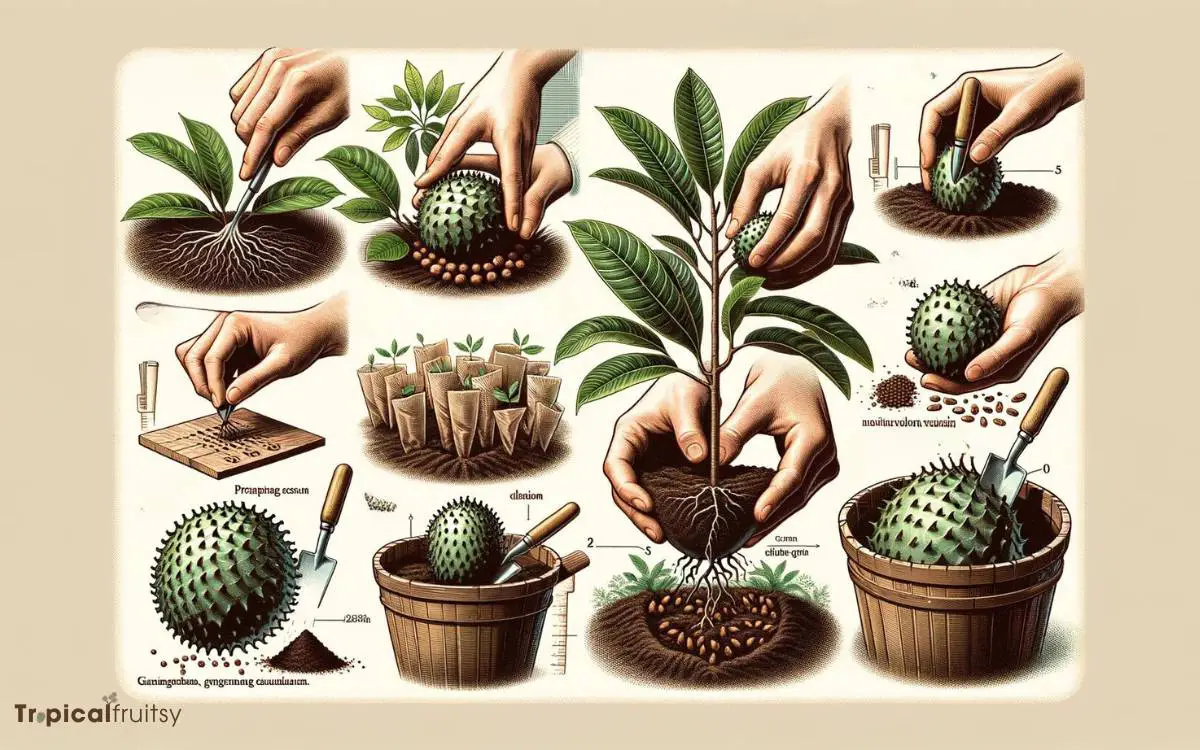
To begin planting your soursop seed, it is crucial to adhere to specific seed preparation steps to enhance the likelihood of successful germination.
The choice of soil is paramount; optimal soil conditions for soursop involve well-draining, slightly acidic to neutral pH levels, and high organic matter content.
Understanding the germination timeframe, which typically spans several weeks, allows for appropriate planning and care during the early stages of growth.
Seed Preparation Steps
Preparing soursop seeds for planting involves careful extraction and cleaning to ensure optimal germination conditions.
Once a fresh soursop fruit is acquired, the following steps should be taken:
Extraction and Cleaning:
- Remove the seeds: Cut the soursop fruit open and extract the seeds.
- Clean the seeds: Wash the seeds with water to remove the fruit’s flesh, which can inhibit germination if left attached.
- Air dry the seeds: Place the seeds on a paper towel and allow them to air dry for a few hours to prevent fungal growth.
This methodical process is crucial for successful germination, as it prevents rot and promotes a healthy start for the seedling. Each step is designed to foster the ideal conditions for a soursop seed to thrive once planted.
Optimal Soil Conditions
Select a well-draining, slightly acidic soil with a pH between 5.5 and 6.5 to provide your soursop seed with the ideal environment for root development and growth.
The texture of the soil should be loamy, which means it is composed of a balance of sand, silt, and clay, allowing for adequate moisture retention while preventing waterlogging, which can be detrimental to the soursop’s roots.
Organic matter is also crucial; consider incorporating compost or well-rotted manure to enhance soil fertility and structure.
Ensure the planting site gets ample sunlight and has good air circulation to support the health of your soursop tree.
Proper soil preparation will set the stage for a strong, productive plant that can bear the unique, delicious fruits you anticipate.
Germination Timeframe
Soursop seeds typically require between 15 to 30 days to germinate under optimal conditions.
Achieving a successful germination process involves careful attention to several factors:
Temperature and Humidity:
- Ideal temperature range: 25°C to 28°C (77°F to 82°F).
- Maintain high humidity with a plastic cover or propagation dome.
Soil Preparation:
- Use a well-draining soil mix rich in organic matter.
- Soil pH should be slightly acidic to neutral (pH 5.5 to 7).
Watering and Light:
- Keep the soil consistently moist but not waterlogged.
- Provide indirect light; avoid direct sunlight which can scorch young seedlings.
Routine Tree Care
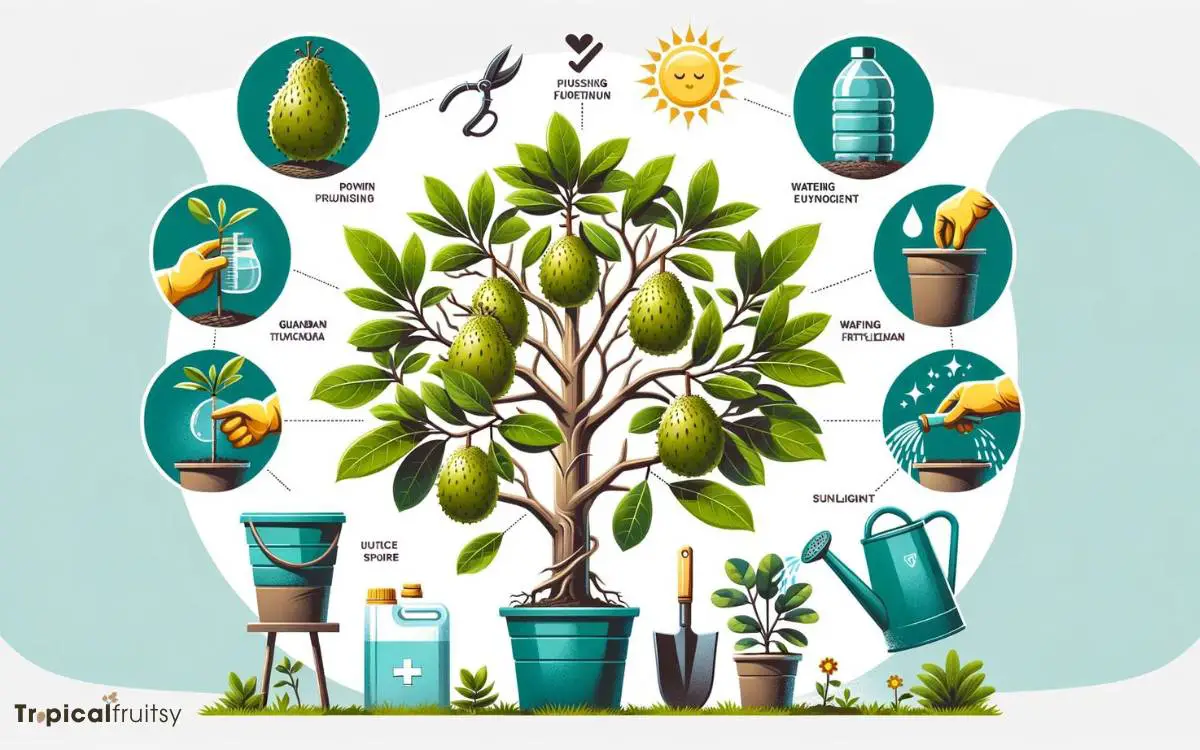
Regular maintenance is essential for the optimal health and productivity of any soursop tree in a home garden setting.
To ensure vigorous growth and abundant fruiting, it is crucial to establish a consistent care routine that addresses watering, fertilization, pruning, and pest management.
Soursop trees prefer evenly moist soil; thus, regular watering during dry periods is necessary, but take care to avoid waterlogging.
A balanced, slow-release fertilizer applied during the growing season supports healthy development.
Pruning should be undertaken to remove dead or overcrowded branches, which promotes good air circulation and light penetration.
Pest and Disease Management
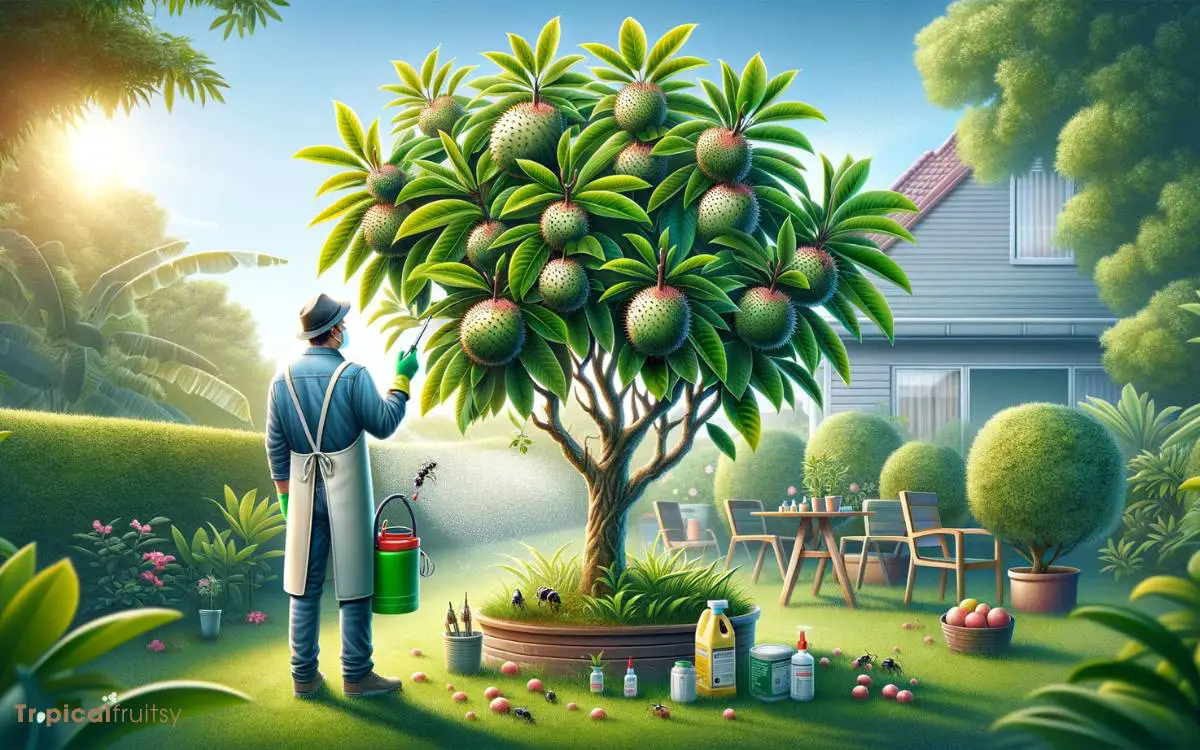
In the cultivation of guanabana trees, effective pest and disease management is essential for the prevention of infestations and the promotion of a healthy, fruit-bearing plant.
Vigilance and timely interventions can mitigate the impact of common issues, ensuring the longevity and productivity of the tree.
Pest Control Strategies:
- Regular inspection for signs of pests like aphids, mealybugs, and scale insects.
- Application of organic insecticides or introducing natural predators.
- Removal of affected parts to prevent spread.
Disease Prevention Measures:
- Ensuring proper air circulation through pruning.
- Watering at the base to avoid wetting foliage, reducing fungal risks.
- Applying fungicides when necessary, following eco-friendly practices.
Integrated Management:
- Combining cultural, biological, and chemical controls.
- Monitoring and adjusting practices based on seasonal changes.
- Keeping abreast of local agricultural extensions for emerging threats.
Can I Grow Ackee Tree at Home to Make the National Dish of a Country?
Yes, you can grow an ackee tree at home to make the ackee and saltfish national dish of Jamaica. The ackee fruit is an important ingredient in this traditional dish, and it can be cultivated in warm, tropical climates. So, if you have the right conditions, you can grow your own ackee tree and enjoy this iconic Jamaican meal.
Harvesting and Enjoying Fruit

Harvesting soursop at the optimal time is crucial for enjoying its unique flavor and nutritional benefits.
Recognizing ripe fruit indicators, such as a slight yellowing of the skin and a softening of the flesh, ensures that the soursop is at its peak of sweetness and texture.
Once harvested, following proper post-harvest storage tips, including keeping the fruit at room temperature until consumption and refrigerating any uneaten portions, will maintain its quality and extend its shelf life.
Ripe Fruit Indicators
Often, discerning when a soursop fruit is ripe for harvest hinges on subtle changes in its color, texture, and aroma.
Gardeners and fruit enthusiasts should keenly observe the following indicators:
Color:
- Shifts from a dark green to a lighter green
- May develop a yellowish hue
Texture:
- Yields slightly to gentle pressure
- Spines soften and spread slightly apart
Aroma:
- Emits a strong, sweet, and fruity scent
- Becomes noticeable without having to cut the fruit open
These signs are critical in determining the perfect moment for harvesting. Waiting for the precise stage of ripeness ensures that the soursop can be enjoyed at its peak flavor and nutritional value, providing a delectable tropical treat for those who cultivate and savor this unique fruit.
Post-Harvest Storage Tips
Upon harvesting a ripe soursop, proper storage is essential to maintain its freshness and extend the enjoyment of its distinctive flavor.
The tropical nature of soursop means it’s sensitive to cold and can be damaged by refrigeration if not handled carefully.
To ensure optimal storage, here is a practical guide:
| Storage Method | Expected Shelf Life |
|---|---|
| Room Temperature | 2-5 days |
| Refrigerator | 1-2 weeks |
| Freezer (pulp) | 3-6 months |
| Puree in Airtight Container | 1 month |
| Dried Soursop Leaves | Up to 1 year |
Maintain the fruit in a well-ventilated area away from direct sunlight to prevent over-ripening. If refrigeration is necessary, wrap the soursop in a paper towel and place it in a perforated plastic bag to avoid moisture buildup.
Enjoy your soursop fresh, or explore various preservation methods to savor its unique taste even longer.
Conclusion
The soursop tree, a botanical marvel, offers a bounty of luscious fruits that tantalize the palate with a symphony of flavors.
Cultivating this tropical treasure at home requires a harmonious blend of patience, precision, and passion. With vigilant care, one can triumph over the most ruthless pests and diseases, ensuring a fruitful harvest.
The soursop’s tantalizing taste is a testament to the gardener’s dedication, transforming any garden into an Eden of exotic abundance.






